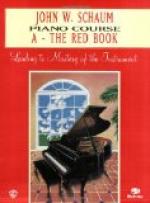On a later occasion, Mr. Ganz said:
“I thoroughly believe in preserving one’s enthusiasm for modern music, even though, at first glance, it does not attract one, or indeed seems almost impossible. I enjoy studying new works, and learning what is the modern trend of thought in piano work; it keeps me young and buoyant.
“One of the novelties lately added to my repertoire is the Haydn sonata in D. On the same program I place the Korngold sonata. A hundred years and more divide the two works. While I revere the old, it interests me to keep abreast of the new thought in musical art and life.”
VI
TINA LERNER
AN AUDIENCE IS THE BEST TEACHER
Between the many engagements that crowded upon the close of her long American tour, Miss Tina Lerner found time to talk over certain topics of significance which bear upon pianistic problems.
We began by referring to the different methods of holding the hands, moving the fingers and touching the keys, as exemplified by the various pianists now before the public.
“It is true that I play with the ball of the finger on the key, which necessitates a flat position of hand, with low wrist.” Here the pianist illustrated the point by playing several pearly scales with straight, outstretched fingers. “I never realized, however, that I played in this way, until Mr. Ernest Hutcheson, the pianist, of Baltimore, recently called my attention to it. The fact is, I have always taken positions of body, arms, hands and fingers, which seemed to me the most natural and easy. This I did when I began, at the age of five, and I have always kept to them, in spite of what various teachers have endeavored to do for me. Fortunately my early teachers were sensible and careful; they kept me at the classics, and did not give too difficult pieces. The principles followed by most great pianists I believe are correct; but I have always kept to my own natural way. In hand position, therefore, I am individual; perhaps no one else plays with such a finger position, so in this I am unique.




